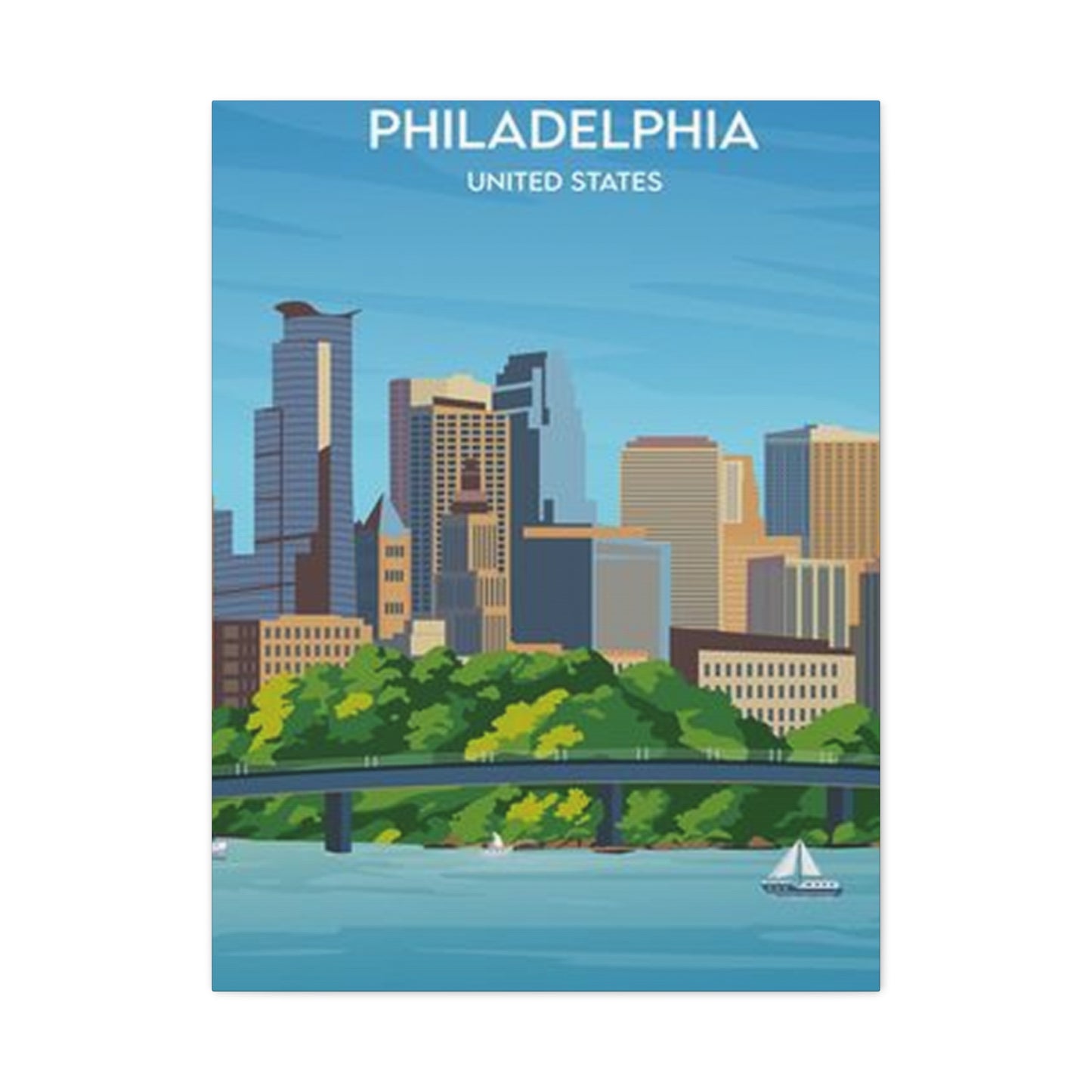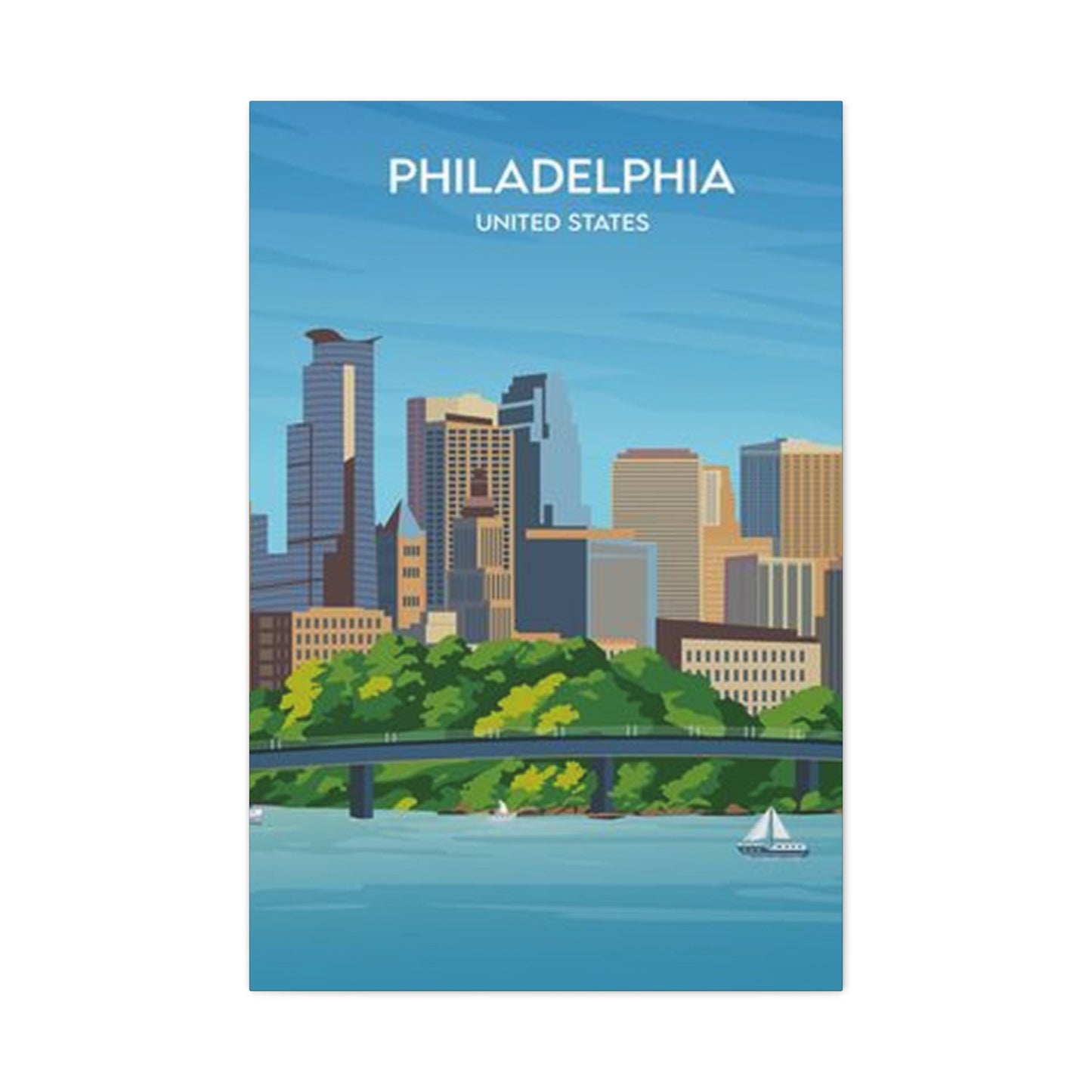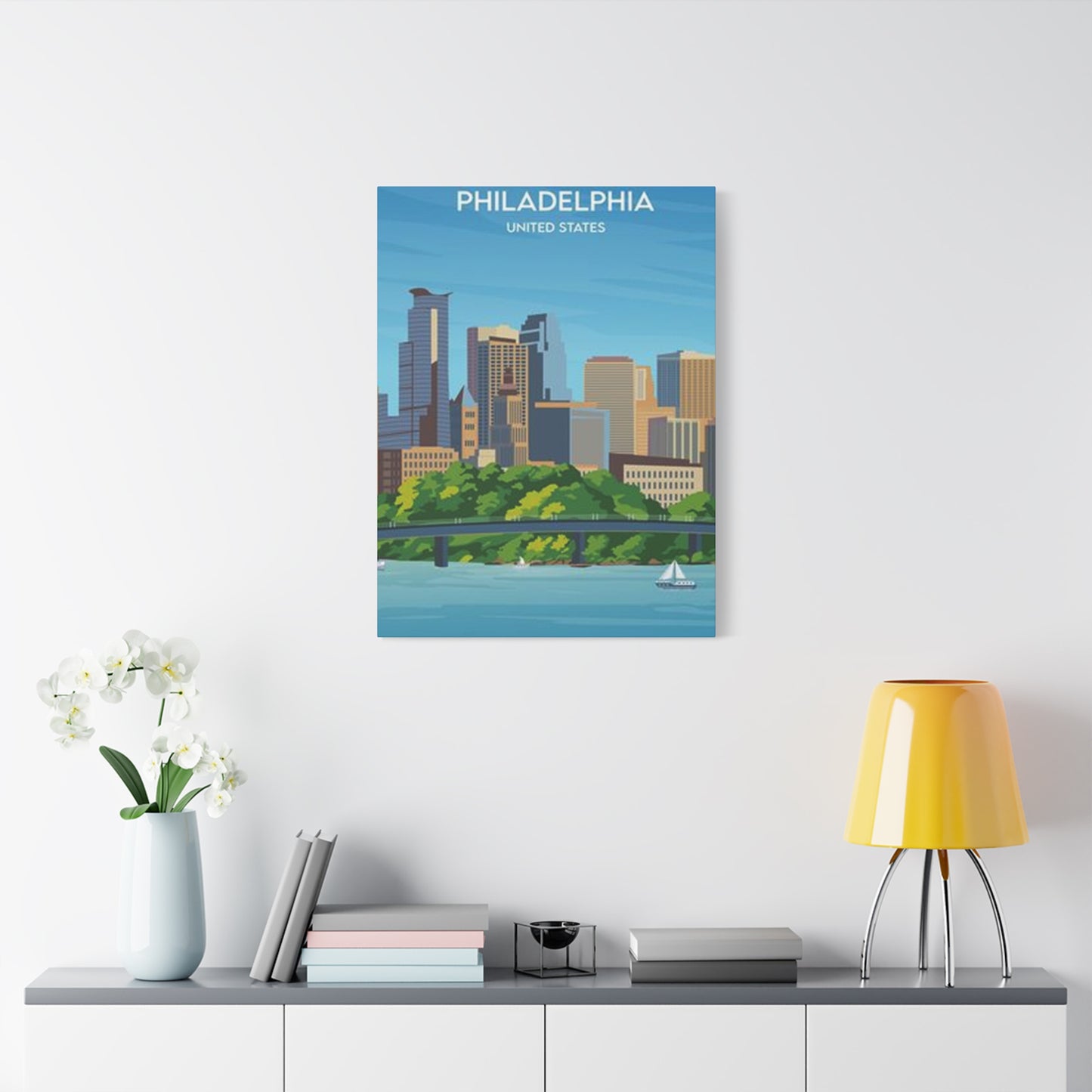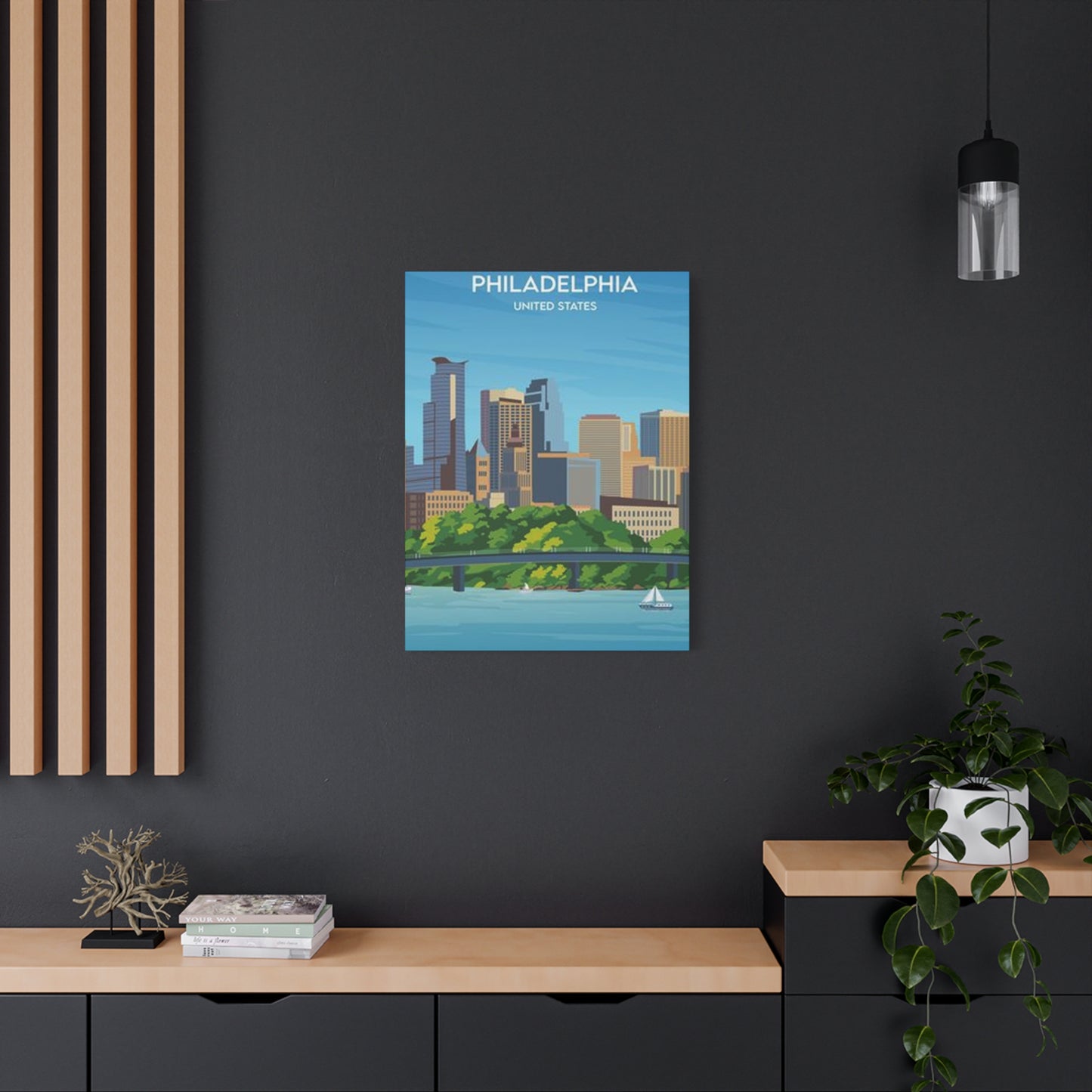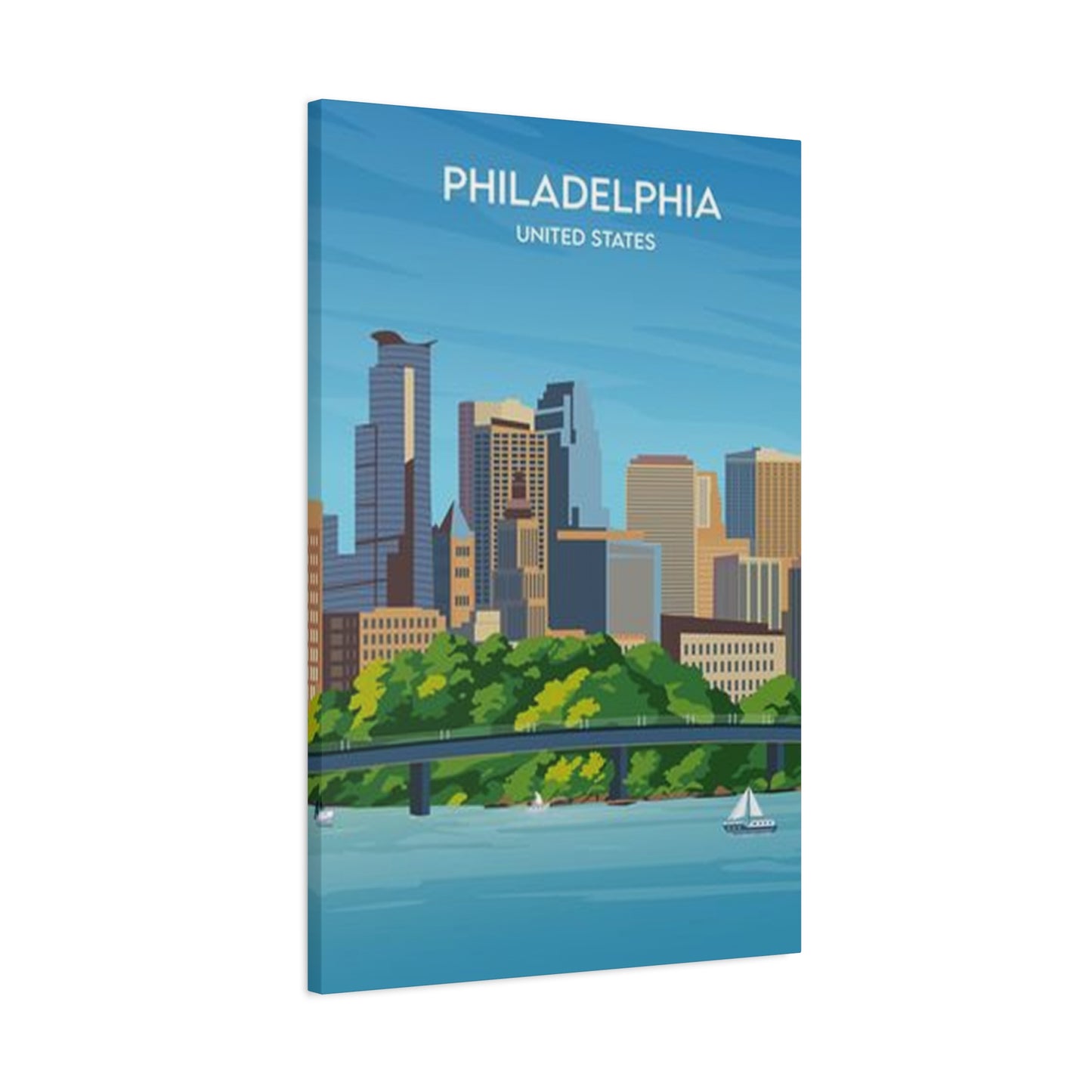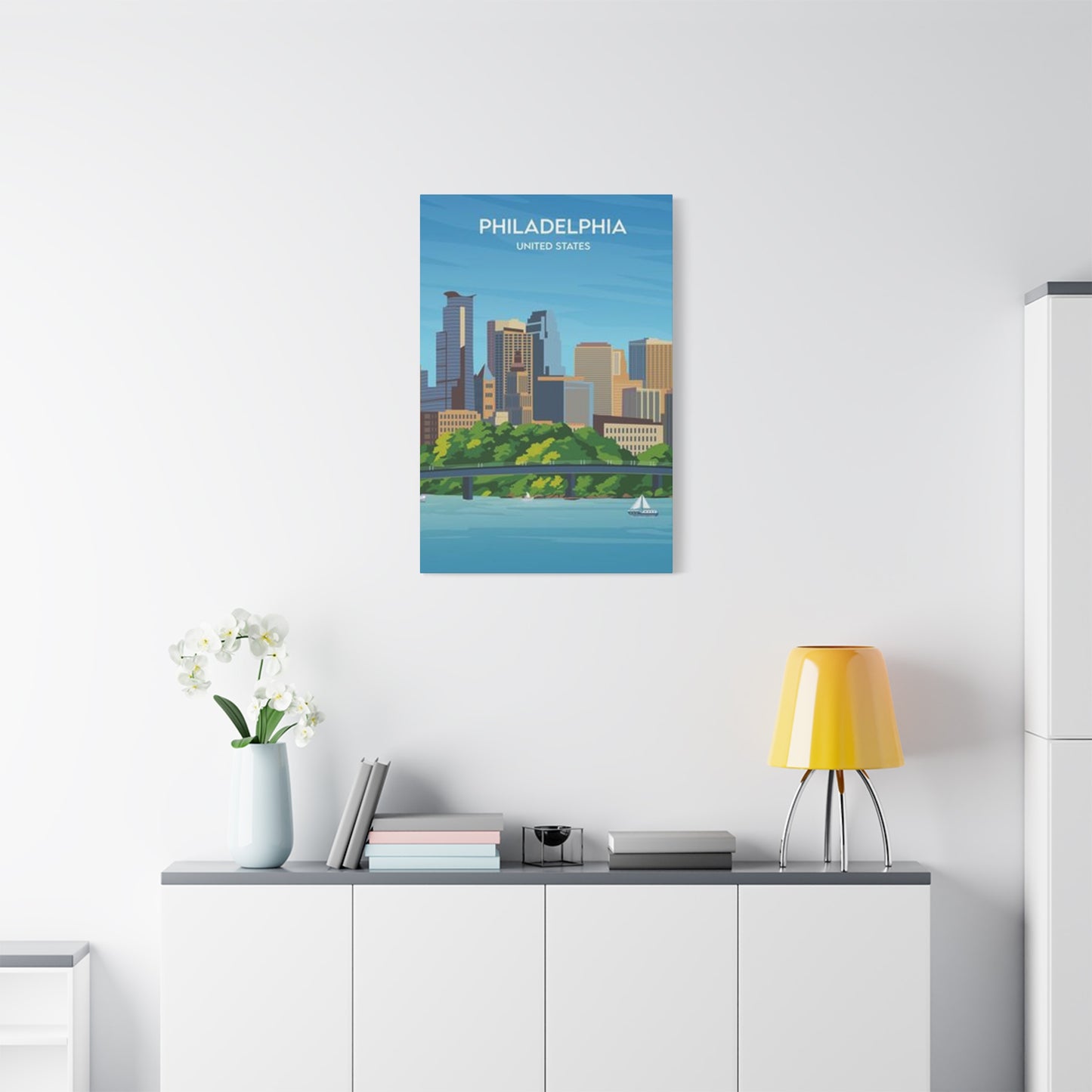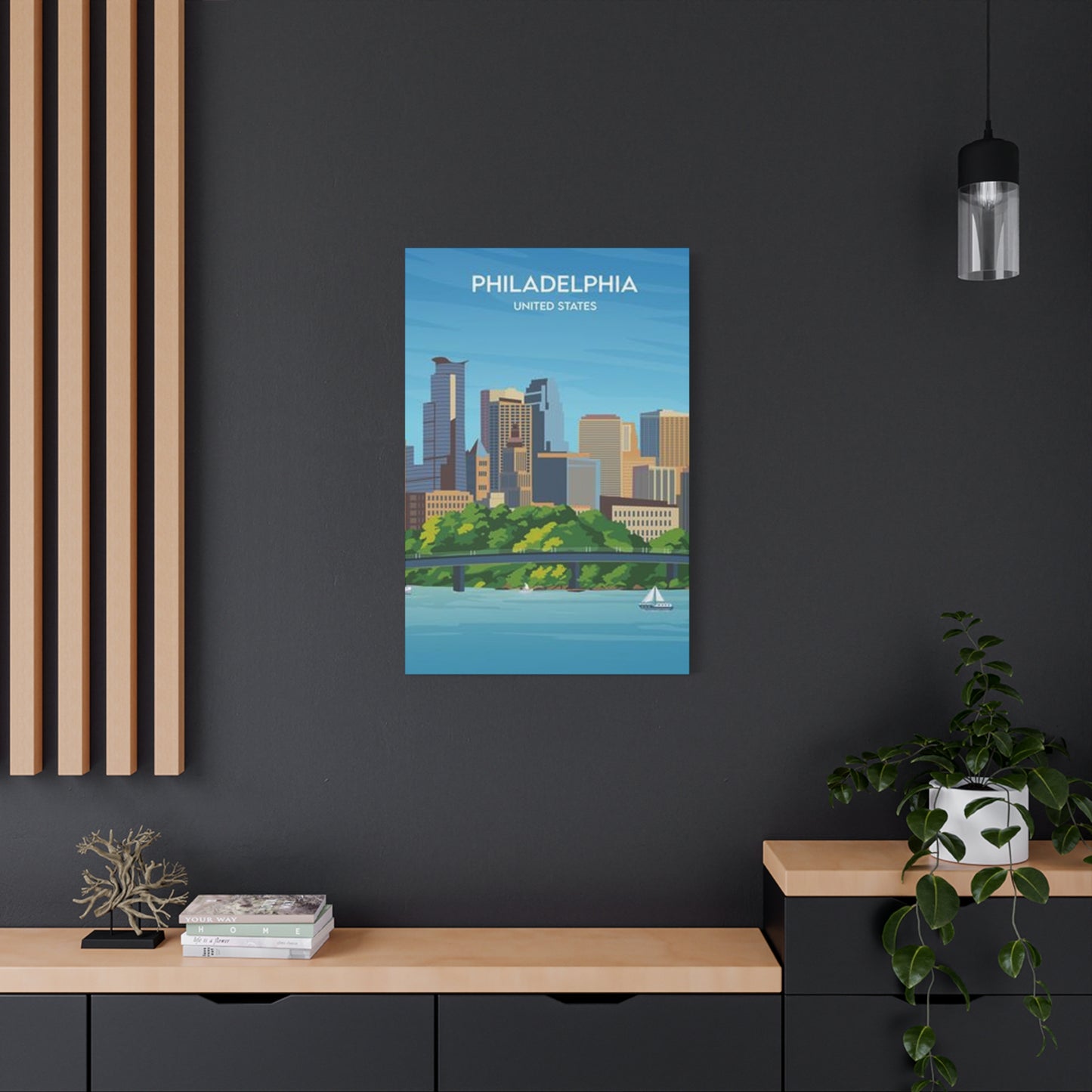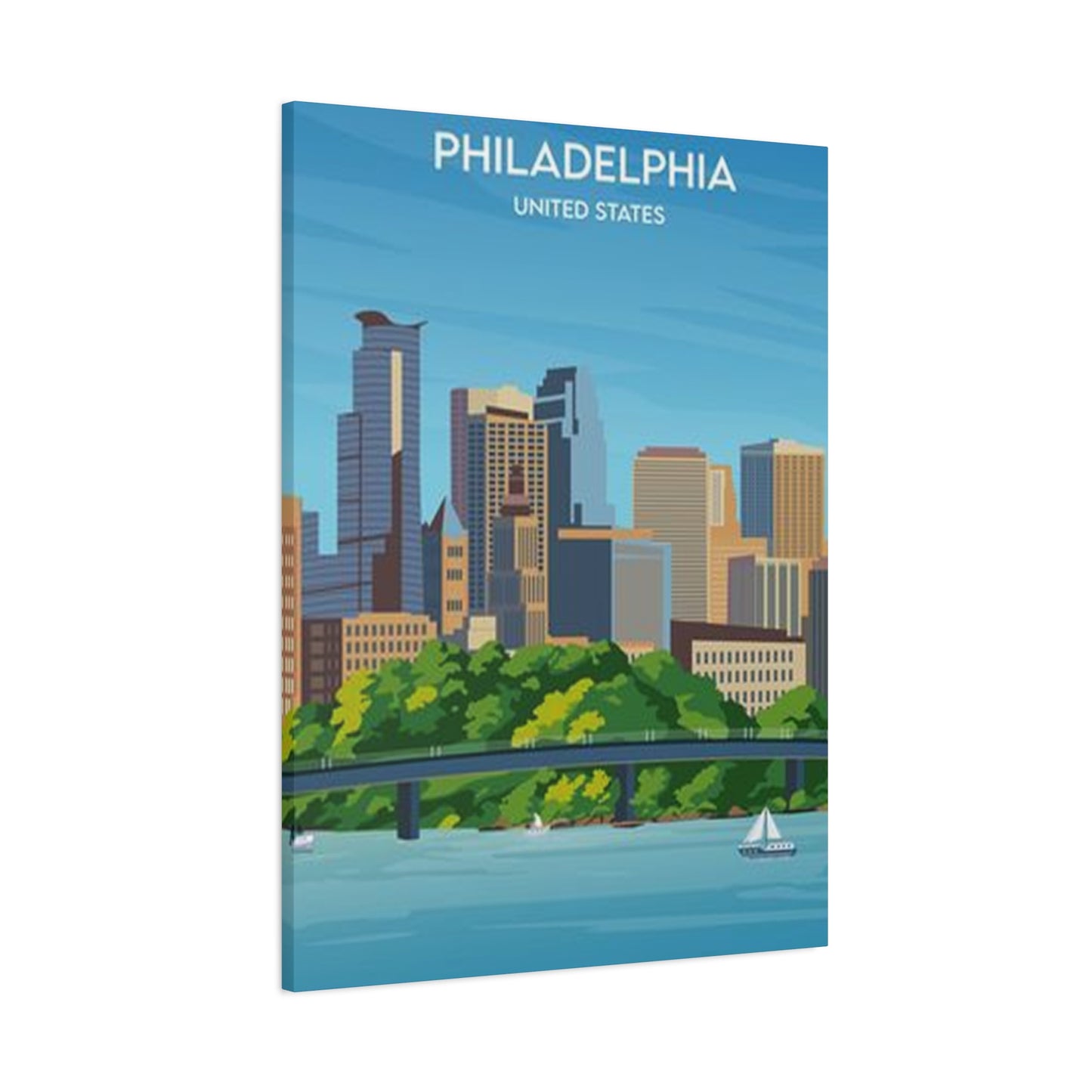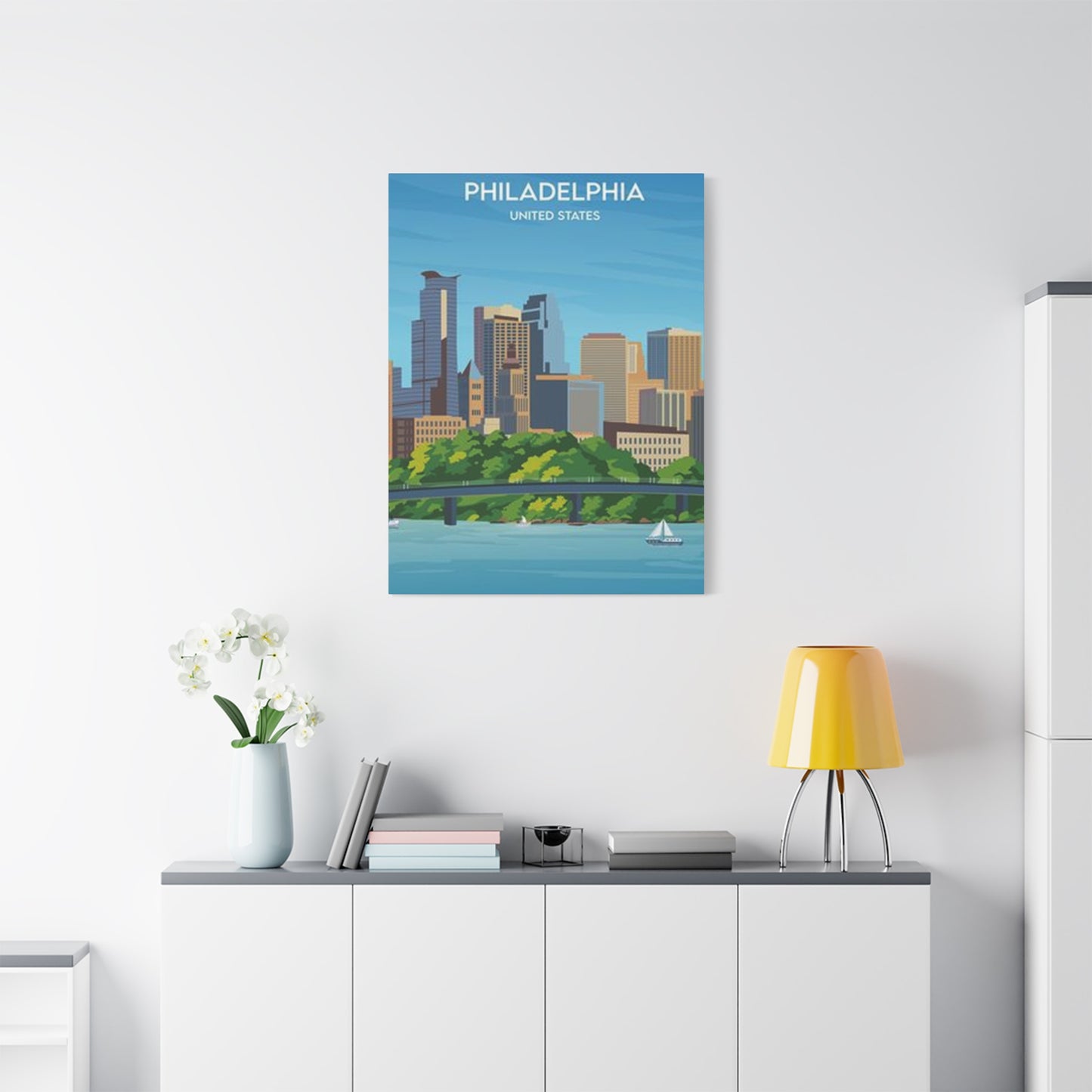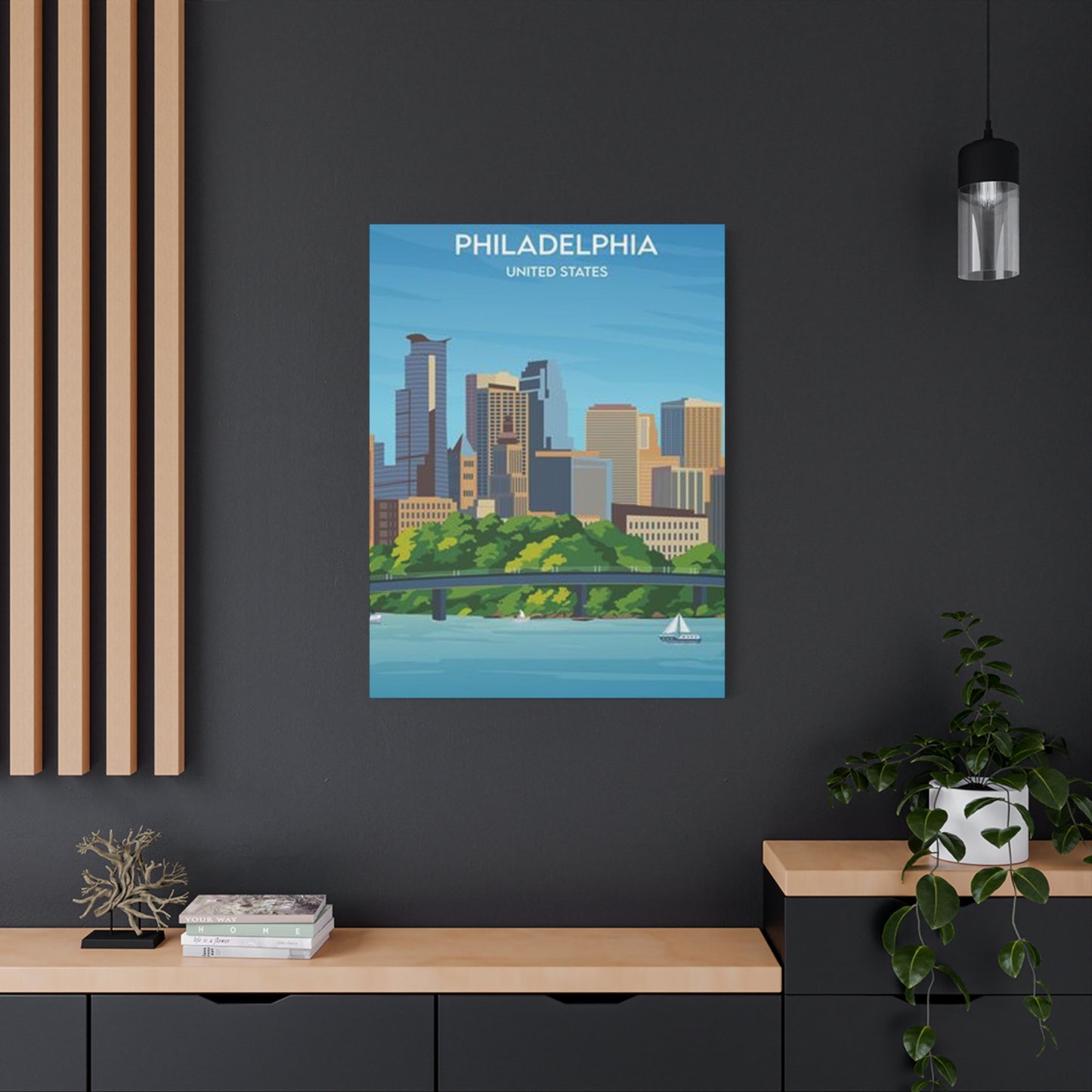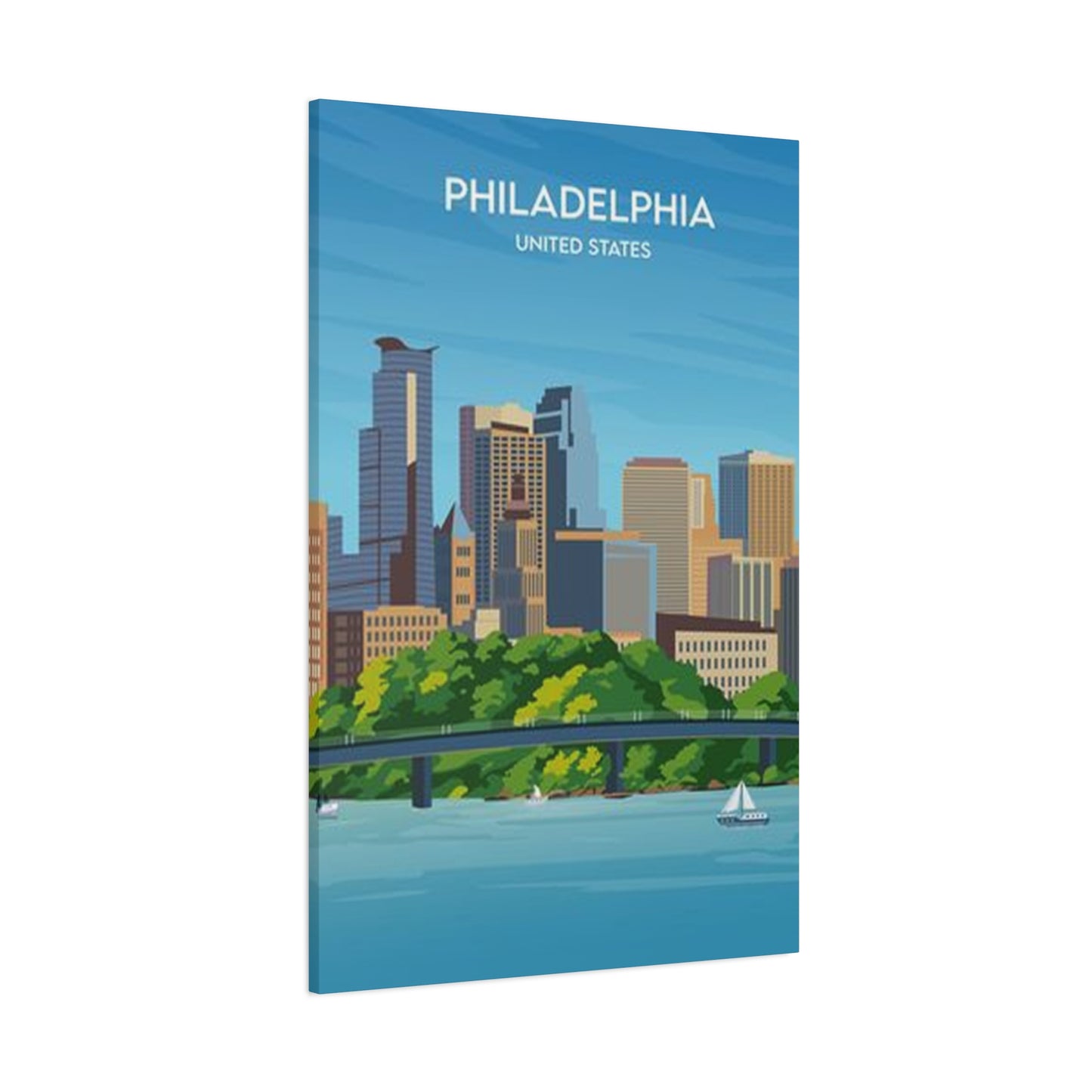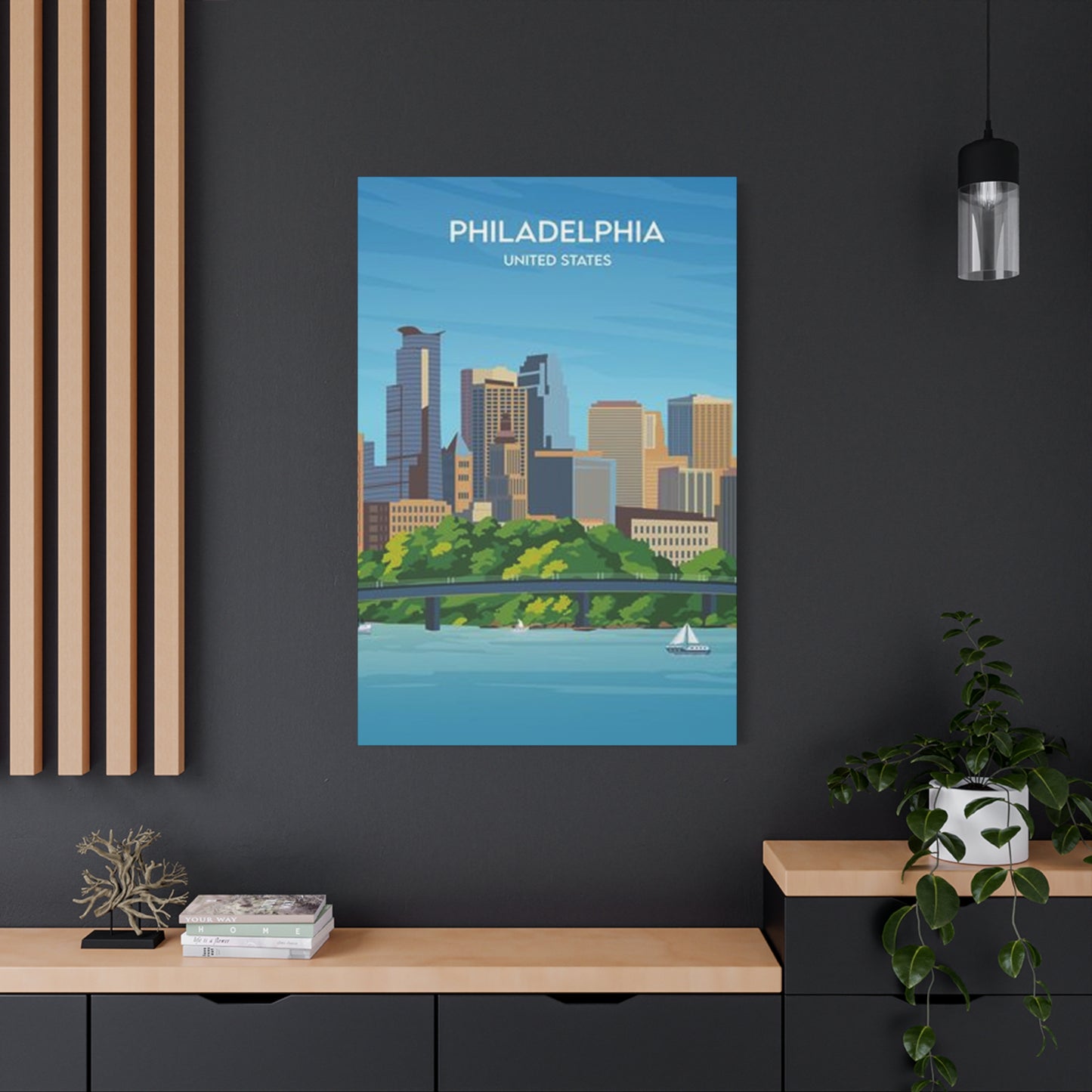City Lights and Liberty: Philadelphia United States Poster Wall Art for Urban Enthusiasts
Philadelphia stands as one of America's most historically significant and visually captivating cities, offering endless inspiration for interior design enthusiasts and art collectors alike. The combination of colonial architecture, modern skyscrapers, and vibrant street culture creates a unique aesthetic that translates beautifully onto canvas and poster prints. This comprehensive guide explores how to incorporate the essence of this remarkable American metropolis into your living spaces through carefully selected wall art that captures the spirit, heritage, and dynamic energy of one of the nation's most beloved urban centers.
The transformation of interior spaces through carefully curated artwork has become an essential aspect of modern home design. When you choose pieces that feature iconic American cityscapes, you're not just decorating walls but creating meaningful connections to places that hold cultural significance. The visual representation of urban landscapes allows homeowners to express their appreciation for architectural beauty, historical importance, and the continuous evolution of American metropolitan areas. Every piece becomes a conversation starter, a window into urban life, and a tribute to the enduring spirit of places that have shaped national identity.
Understanding the appeal of city-themed wall decorations requires recognizing how these pieces function within residential and commercial environments. They serve multiple purposes simultaneously: adding visual interest, establishing color schemes, creating focal points, and expressing personal connections to specific locations. For those who have lived in or visited particular metropolitan areas, these artworks trigger memories and emotional responses. For others, they represent aspirations, travel goals, or appreciation for urban aesthetics. The versatility of such pieces makes them suitable for various interior design styles, from industrial lofts to traditional homes, from minimalist apartments to eclectic creative spaces.
The process of selecting appropriate wall art involves considering numerous factors including size, color palette, framing options, and the specific elements featured within the composition. When focusing on American city themes, you have access to countless perspectives ranging from panoramic skyline views to intimate street scenes, from historical landmarks to contemporary architectural marvels. Each approach offers distinct advantages and creates different atmospheric effects within your space. Understanding these nuances helps in making informed decisions that enhance rather than detract from your overall design vision.
United States Pride in Wall Art
American pride manifests in countless forms throughout interior design, and wall art featuring iconic cityscapes represents one of the most sophisticated and visually appealing expressions of national appreciation. These pieces allow homeowners to celebrate the architectural achievements, urban planning innovations, and cultural diversity that define metropolitan areas across the nation. Unlike overtly patriotic decorations that might feel heavy-handed or dated, sophisticated city artwork provides subtle yet powerful reminders of American ingenuity and progress while maintaining aesthetic appeal that transcends political or generational boundaries.
The concept of displaying national pride through urban imagery has evolved significantly over recent decades. Earlier approaches often relied on literal symbols and obvious iconography, but contemporary design favors more nuanced representations. Modern interpretations of American city scenes emphasize artistic quality, compositional excellence, and emotional resonance rather than simply documenting recognizable structures. This evolution reflects broader trends in interior design where meaning and authenticity take precedence over superficial decoration. When you select artwork featuring American metropolitan landscapes, you're participating in this sophisticated approach to expressing connection with your national heritage.
Cities themselves serve as living monuments to American values and achievements. The skylines that punctuate horizons represent generations of innovation, the streets tell stories of immigrant communities building new lives, and the architecture demonstrates evolving aesthetic sensibilities. Capturing these elements in visual art form creates layered meaning that enriches living spaces. A well-executed canvas print or poster doesn't merely show buildings; it conveys the energy, diversity, and possibility that characterize American urban life. This deeper significance elevates functional decoration into meaningful artistic expression.
Incorporating these themes into home decor requires thoughtful consideration of how specific pieces align with personal values and aesthetic preferences. Some individuals gravitate toward dramatic skyline compositions that emphasize scale and architectural ambition. Others prefer intimate street-level perspectives that highlight daily life and community character. Historical perspectives might appeal to those interested in architectural preservation and urban evolution, while contemporary interpretations attract design-forward homeowners. The key lies in selecting pieces that resonate personally while complementing the existing design elements within your space. Authenticity in selection ensures that your walls reflect genuine appreciation rather than following fleeting trends.
The psychological impact of surrounding yourself with imagery that celebrates national landmarks and urban achievements should not be underestimated. Environmental psychology research demonstrates that the visual elements within our living spaces significantly influence mood, productivity, and overall wellbeing. Artwork depicting thriving cities, impressive architecture, and vibrant public spaces can inspire optimism, ambition, and connection to something larger than individual experience. These subtle psychological benefits accumulate over time, making your home not just a physically comfortable space but an emotionally supportive environment that reinforces positive associations with your national identity and urban culture.
Philly Skyline for Modern Interiors
The distinctive silhouette of the city skyline creates immediately recognizable visual interest that works exceptionally well in contemporary interior spaces. The combination of historic structures and modern high-rises produces a layered composition that appeals to diverse aesthetic sensibilities. When rendered on canvas or high-quality prints, these skyline views offer versatility that allows them to function as focal points in minimalist settings or complementary elements in more eclectic arrangements. The clean lines and geometric forms inherent in architectural photography and illustration align perfectly with modern design principles that emphasize structure, balance, and intentional negative space.
Modern interiors often face the challenge of feeling sterile or impersonal without carefully selected decorative elements. Large-format skyline artwork addresses this issue by introducing visual complexity and cultural reference points without cluttering the space. The horizontal orientation typical of skyline compositions naturally draws the eye across the wall, creating movement and flow that activates otherwise static areas. This horizontal emphasis complements the low-profile furniture common in contemporary design, establishing visual harmony throughout the room. The result feels cohesive and intentional rather than haphazardly assembled.
Color considerations play a crucial role when integrating skyline artwork into modern spaces. Many contemporary interiors utilize neutral palettes with strategic accent colors, and skyline pieces can either reinforce this restraint or provide the pop of color that energizes the entire scheme. Black and white skyline photography offers timeless sophistication that pairs effortlessly with virtually any color palette, while vibrant interpretations featuring sunset skies or artistic color manipulation create dramatic focal points. Understanding how your chosen piece will interact with existing colors ensures visual coherence rather than clashing elements competing for attention.
The scale of skyline artwork significantly impacts its effectiveness within modern interiors. Contemporary design often embraces bold statements and generous proportions, making large-format pieces particularly appropriate. A substantial canvas spanning several feet can anchor an entire wall, eliminating the need for multiple smaller pieces that might fragment visual attention. However, scale must be calibrated to room dimensions and furniture proportions. Oversized artwork in modest spaces can feel overwhelming, while undersized pieces in expansive areas may appear insignificant. Achieving the right balance requires careful measurement and visualization before making final selections.
Lighting considerations become especially important when displaying skyline artwork in modern interiors. These spaces often feature carefully planned lighting schemes that highlight architectural features and create atmospheric effects. Your artwork should integrate into this lighting strategy rather than working against it. Natural light exposure affects how colors appear throughout the day, while artificial lighting can be positioned to enhance specific features of the artwork. Some pieces benefit from direct illumination that emphasizes texture and detail, while others work better with ambient lighting that allows the composition to emerge more subtly. Considering these factors during placement ensures your investment achieves maximum visual impact.
City Lights: Philadelphia Canvas Prints
The illumination of urban landscapes transforms familiar scenes into magical compositions that capture imagination and create atmospheric ambiance within interior spaces. Canvas prints featuring nighttime cityscapes leverage this transformation, offering viewers a different perspective on architectural forms and spatial relationships. When buildings become outlined in light against darkened skies, the emphasis shifts from individual structural details to overall composition and the interplay between illuminated and shadowed areas. This creates dramatic visual interest that functions particularly well in spaces where you want to establish a sophisticated, slightly mysterious atmosphere.
The technical quality of canvas prints determines their long-term visual appeal and durability. Superior printing processes utilize archival inks that resist fading even with extended light exposure, ensuring your investment maintains its vibrancy for years. The canvas material itself should feature appropriate weight and texture that enhances rather than detracts from the image. Gallery-wrapped canvases where the image extends around the edges eliminate the need for traditional framing, creating a contemporary presentation that integrates seamlessly with modern interiors. Understanding these technical specifications helps distinguish genuinely high-quality pieces from inferior alternatives that may initially appear similar but deteriorate rapidly.
Composition becomes especially critical in nighttime city scenes where the distribution of light and dark areas creates the fundamental structure of the image. Skilled photographers and artists understand how to balance illuminated focal points with darker supporting elements, guiding viewer attention through the composition in a deliberate sequence. The best pieces avoid overwhelming brightness that flattens the image while also preventing excessive darkness that obscures important details. This careful calibration creates depth and dimensionality that draws viewers into the scene, making them feel as though they could step into the illuminated streets depicted on the canvas.
The emotional resonance of city lights imagery stems partly from universal associations with urban nightlife, possibility, and the romance of metropolitan areas after dark. These pieces evoke feelings of excitement, sophistication, and connection to vibrant cultural scenes. For some viewers, they trigger memories of specific experiences in particular cities, while for others they represent aspirational lifestyles or future travel destinations. This emotional dimension elevates purely decorative function, transforming wall art into meaningful personal expressions that reflect values, experiences, and dreams.
Placement strategies for illuminated cityscape canvases differ somewhat from daytime compositions. These pieces often work exceptionally well in spaces used primarily during evening hours, where they complement the ambient lighting conditions. Dining rooms, entertainment areas, and bedrooms can all benefit from the atmospheric quality these artworks provide. However, they also create interesting contrast when displayed in naturally bright spaces, offering a different perspective that highlights the duality of urban environments. Considering the primary usage patterns of different rooms helps determine where these pieces will achieve maximum impact and appreciation.
American Heritage in Poster Form
Poster art has experienced a remarkable renaissance as collectors and interior designers rediscover the medium's versatility, accessibility, and bold visual impact. When focused on themes of national heritage and iconic urban landscapes, posters offer an affordable yet sophisticated approach to incorporating meaningful imagery into residential and commercial spaces. The poster format allows for diverse artistic interpretations ranging from photorealistic representations to highly stylized illustrations, providing options that suit varied aesthetic preferences and budget constraints without compromising on visual quality or cultural significance.
The historical relationship between poster art and American visual culture runs deep, with traditions extending back to transportation advertisements, entertainment promotions, and public information campaigns that have become collectible artifacts documenting cultural evolution. Contemporary poster art builds on these traditions while incorporating modern design sensibilities and printing technologies that deliver unprecedented color accuracy and detail. This fusion of historical medium and contemporary execution creates pieces that feel both timeless and current, allowing them to function effectively within traditional and modern interior schemes alike.
Selecting posters that authentically represent heritage themes requires discernment regarding both subject matter and execution quality. The most effective pieces balance recognizable landmarks or scenes with artistic interpretation that transcends simple documentation. Whether featuring historic architecture, cultural symbols, or iconic urban vistas, these posters should offer fresh perspectives that invite repeated viewing rather than becoming visual wallpaper that fades into background irrelevance. Artistic choices regarding color palette, compositional structure, and level of detail all contribute to whether a piece maintains long-term visual interest or quickly feels dated and disposable.
Framing decisions dramatically impact how poster art presents within your space. While some contemporary designs work well with simple clip frames or even magnetic hanging systems that allow easy rotation of displayed pieces, heritage themes often benefit from more substantial framing that conveys appropriate gravitas. Matting creates visual separation between the artwork and frame while also providing physical protection for the print. Frame materials and finishes should complement both the artwork itself and the surrounding interior elements. Wood frames can emphasize traditional or rustic design directions, while metal frames align with industrial or contemporary aesthetics. These choices transform a simple poster into a curated art piece that commands appropriate attention and respect.
The layering possibilities that poster art facilitates represent another significant advantage. Because individual posters typically cost considerably less than canvas prints or original artwork, collectors can assemble thematic groupings that create gallery wall installations spanning entire sections of larger rooms. When unified by consistent themes such as American heritage or specific city focus, these multi-piece arrangements generate visual impact exceeding what any single artwork could achieve. The arrangement itself becomes an artistic statement, with careful attention to spacing, alignment, and compositional balance determining overall effectiveness. This approach allows for gradual collection building, adding pieces over time as you discover works that resonate and complement existing selections.
Philadelphia Landmarks That Inspire Décor
Iconic structures within any major metropolitan area serve as powerful symbols that instantly communicate place identity and cultural significance. These landmarks become visual shorthand for entire cities, carrying associations that extend far beyond their physical structures. When incorporated into interior décor, they function as conversation pieces that reveal interests, experiences, and aesthetic preferences. The most effective landmark-focused artwork balances immediate recognition with artistic interpretation that offers fresh perspectives on familiar subjects, preventing the pieces from feeling like generic tourist memorabilia.
The architectural diversity found throughout the city provides rich material for artistic exploration. From historic buildings that witnessed the birth of the nation to contemporary structures pushing boundaries of engineering and design, the range of available subjects ensures options appropriate for diverse interior styles. Traditionalists might gravitate toward artwork featuring colonial-era architecture with its symmetry, classical proportions, and historical gravitas. Modernists often prefer stark contemporary structures with bold geometric forms and innovative materials. This architectural variety means that landmark-focused décor can successfully integrate into virtually any design scheme when selections align with overall aesthetic direction.
Perspective and framing choices significantly influence how landmark artwork functions within interior spaces. Close-up architectural details emphasizing texture, materials, and craftsmanship create intimate pieces suitable for smaller walls or tight arrangements. These detail-focused works reward close examination, revealing subtleties that become more apparent with repeated viewing. Alternatively, broader compositions that show landmarks within their urban context provide environmental information that situates structures within the larger cityscape. These contextual approaches help viewers understand spatial relationships and the ways individual buildings contribute to overall urban character. Neither approach is inherently superior; effectiveness depends on available wall space, viewing distances, and the specific atmosphere you want to create.
The historical significance attached to certain landmarks adds layers of meaning that transcend pure visual appeal. Structures that witnessed pivotal moments in national history carry associations that resonate particularly strongly with history enthusiasts and those who value connections to the past. Displaying artwork featuring these historically significant sites can serve educational purposes, particularly in homes with children, while also expressing values regarding heritage preservation and historical awareness. However, this historical dimension should enhance rather than overwhelm aesthetic considerations. The most successful pieces work effectively as visual art independent of historical knowledge, with the historical context providing enriching additional meaning for those aware of it.
Contemporary artistic interpretations of traditional landmarks create fascinating tension between old and new that appeals to collectors seeking pieces that feel both rooted and forward-looking. Artists employing unusual color palettes, abstracted forms, or unexpected compositions transform familiar subjects into fresh visual experiences. These interpretive approaches prevent landmark imagery from feeling stale or overly literal while maintaining recognizability that grounds the work in specific place identity. For interior designers working to balance traditional and contemporary elements within single spaces, these hybrid pieces often provide perfect bridging elements that honor history while embracing modern aesthetic sensibilities.
Urban Philadelphia in Modern Art
The translation of urban environments into contemporary artistic expression involves sophisticated visual strategies that go beyond simple documentation or representation. Modern artists approaching city themes employ diverse techniques including abstraction, selective focus, unusual perspectives, and digital manipulation to reveal underlying patterns, emotional qualities, and conceptual meanings within metropolitan landscapes. These approaches transform familiar urban elements into thought-provoking compositions that challenge viewers to reconsider their relationships with built environments and question assumptions about how cities function as visual and social spaces.
Abstract interpretations of urban themes offer particular advantages for collectors seeking versatile pieces that complement minimalist or contemporary interiors. By reducing cityscapes to essential forms, colors, and compositional structures, abstract artists create works that suggest rather than depict, allowing viewer imagination to complete the experience. This openness to interpretation means individual viewers may perceive different meanings or emphasize different elements, making the artwork personally relevant in varied ways. The reduced specificity also ensures these pieces avoid the risk of feeling dated as specific buildings change or urban landscapes evolve, providing longer-term relevance than highly detailed, time-specific representations.
Color field approaches to urban subjects utilize expansive areas of color to convey atmospheric qualities and emotional responses to city environments. Rather than precisely rendering architectural details, these works capture the overall feeling of being within urban spaces through chromatic relationships and tonal variations. Cool blue-gray palettes might evoke early morning stillness in empty streets, while vibrant warm tones suggest the energy of peak activity hours. These emotional translations of urban experience resonate with viewers on visceral levels that bypass intellectual analysis, creating immediate gut-level responses that make the artwork feel personally meaningful even without conscious understanding of specific artistic strategies being employed.
Mixed media approaches combine multiple techniques and materials to create textured, layered compositions that emphasize the complexity and density characteristic of metropolitan areas. Artists might incorporate photographic elements with painted passages, add collaged materials referencing urban ephemera, or build up thick paint applications that create actual three-dimensional relief. These textural variations add physical presence that engages viewers beyond purely optical experience. The interplay between different materials and techniques can metaphorically represent the diversity of urban populations, the layers of history visible in aged infrastructure, or the constant change characterizing dynamic city environments.
Digital art and computational approaches to urban imagery represent emerging directions that appeal particularly to technology-enthusiastic collectors and those furnishing contemporary commercial or residential spaces. Artists working with digital tools can manipulate photographic source material in ways impossible through traditional techniques, creating surreal juxtapositions, impossible perspectives, or visualizations of abstract data related to urban systems. These technologically sophisticated approaches feel appropriate for modern interiors while also commenting on the increasing digitization of contemporary life and the ways technology mediates our experience of physical spaces. As these works often exist primarily as digital files, they also offer interesting possibilities for display on digital screens that allow rotation through multiple pieces or even animated sequences.
United States Skyline Wall Inspiration
Skyline compositions possess inherent drama that makes them natural focal points within interior spaces. The vertical thrust of towers against horizontal expanses of sky creates dynamic tension that energizes walls and activates spaces. When these skylines represent significant American cities, they carry additional meaning beyond pure formal qualities, connecting interior spaces to specific places and the cultural associations they evoke. This combination of visual impact and meaningful reference makes skyline artwork particularly effective for those seeking pieces that function both aesthetically and symbolically.
The variety of available skyline perspectives ensures options suitable for different interior requirements and personal preferences. Classic straight-on views emphasize the collective profile of multiple buildings massed together, creating iconic silhouettes immediately associated with specific cities. These frontal perspectives work especially well for larger walls where horizontal span can be fully utilized. Alternatively, elevated perspectives looking down on skylines from nearby hills or taller structures provide bird's-eye views that reveal urban grid patterns and spatial relationships between different districts. These overhead views create different compositional structures with more complex spatial dynamics that reward extended viewing.
Seasonal variations in skyline imagery offer opportunities to refresh interior atmosphics without completely replacing artwork. The same skyline photographed under different conditions appears remarkably different, with winter snow creating stark contrast and simplified forms, spring greenery softening hard edges, summer haze producing atmospheric depth, and autumn color providing warm tonal ranges. Collectors who appreciate seasonal change might assemble multiple versions of favored skylines that can be rotated throughout the year, keeping the visual environment dynamic and responsive to changing external conditions. This approach also allows experimentation with different color palettes and atmospheric effects while maintaining consistent subject matter.
Time-of-day variations provide another dimension of diversity within skyline imagery. Dawn silhouettes with buildings backlit against colorful skies create dramatic contrast and optimistic associations with new beginnings. Midday photography under full sun emphasizes architectural details and creates crisp, clear renditions suitable for contemporary spaces valuing precision and clarity. Late afternoon golden hour lighting bathes buildings in warm tones that feel welcoming and nostalgic. Night scenes transform skylines into constellations of artificial light that emphasize the energy and vitality of urban environments. Each temporal variation creates distinctly different atmospheric effects appropriate for different spaces and moods.
Panoramic formats that extend skyline compositions across extremely wide formats create immersive experiences that dominate walls and define spatial character. These expansive works require substantial wall space but deliver proportional impact, making them ideal for commercial installations, large residential great rooms, or any space where you want to create a dramatic architectural statement. The extended horizontal format encourages eye movement across the composition, creating dynamic viewing experiences that prevent visual boredom. However, panoramic pieces require careful consideration regarding viewing distance and furniture placement to ensure the full composition remains visible and doesn't become visually fragmented by intervening objects or inadequate viewing perspective.
Philly Charm Meets Contemporary Design
The intersection of historical character and modern design sensibility creates compelling aesthetic territory that appeals to sophisticated collectors seeking pieces that honor tradition while embracing contemporary expression. This fusion approach acknowledges the richness of accumulated urban history while refusing to remain trapped in nostalgic reverence for the past. The resulting aesthetic feels both grounded and forward-looking, providing visual interest through the productive tension between old and new rather than choosing one at the expense of the other.
Successful integration of traditional urban imagery into contemporary spaces requires careful attention to presentation and context. While the subject matter might reference historical architecture or long-established urban patterns, the treatment, framing, and display approach should align with modern design principles. Clean-lined frames, minimal matting, and strategic placement that respects negative space help traditional subjects feel contemporary rather than dated. This careful calibration allows historically significant imagery to coexist comfortably with modern furnishings and current design trends without creating jarring stylistic conflicts that undermine overall cohesion.
Material choices play a crucial role in determining whether urban imagery feels contemporary or traditional. Canvas prints offer texture and depth that create artistic presence, while acrylic-mounted photography provides sleek, modern presentation with impressive color saturation and dimensional quality. Metal prints deliver industrial edge appropriate for loft spaces and contemporary commercial environments. The same image rendered on different materials produces distinctly different effects, making material selection an important aspect of overall design strategy. Understanding how various substrate options influence perception helps match technical execution to aesthetic goals.
Color palette management becomes especially important when attempting to bridge historical subject matter and contemporary design context. Sepia tones and muted colors can make even modern compositions feel dated, while overly saturated or artificially manipulated colors might feel garish and undermine the authenticity of historical subjects. The most successful pieces typically employ restrained color approaches that feel neither aggressively modern nor nostalgically historical. Black and white treatments often navigate this territory effectively, feeling simultaneously timeless and contemporary while allowing architectural forms and compositional structure to receive primary emphasis.
The scale at which historical urban imagery is displayed significantly impacts whether it reads as contemporary or traditional. Oversized presentation of subjects that would traditionally appear in modest formats creates immediate contemporary impact through unexpected proportion. A detail from a historical building blown up to occupy an entire wall transforms from documentation to abstract composition, emphasizing form, texture, and pattern over literal representation. This scale manipulation represents a distinctly contemporary approach that revitalizes historical subjects by forcing viewers to see familiar elements in unfamiliar ways.
Canvas Prints That Celebrate America
Canvas printing technology has democratized access to museum-quality art reproduction and photographic presentation, making it possible for average consumers to display images with remarkable color fidelity and impressive physical presence. When focused on themes celebrating national identity and iconic American locations, canvas prints allow homeowners to express patriotic sentiment through sophisticated visual means that avoid the clichés and heavy-handedness that can make overt patriotic décor feel dated or kitsch. The key lies in selecting images and artistic treatments that work primarily as compelling visual compositions while carrying secondary associations with national identity and place-based meaning.
The canvas medium itself carries artistic associations that elevate printed images beyond what similar compositions would achieve on paper or other substrates. The texture of canvas adds dimensional quality that creates more engaging viewing experiences, with light interacting with the woven surface to produce subtle variations in how colors appear from different angles. This physical dimension makes canvas prints feel more like original paintings than photographic reproductions, adding perceived value and artistic legitimacy. For images celebrating American themes, this elevated presentation conveys respect and reverence appropriate to significant subjects without requiring heavy-handed symbolic treatment.
Gallery wrap presentation, where printed canvas extends around stretcher bar edges, creates finished pieces ready for hanging without additional framing. This contemporary presentation style has become increasingly popular because it reduces visual boundaries between artwork and surrounding wall, creating cleaner integration into modern interiors. The image wrapping around edges also eliminates the distracting white borders that traditionally appear between image and frame in conventionally presented work. For American-themed imagery, gallery wrap presentation feels confident and direct, allowing the content to make its statement without ornamental framing that might complicate or dilute the message.
Size considerations become particularly important with canvas prints because the medium scales effectively to very large formats that would be prohibitively expensive in traditional framed photography or original painting. Large-format celebration of American themes creates impressive focal points that command attention and make strong design statements. However, scale must be appropriate to viewing distance and surrounding space. An enormous canvas in a small room can feel overwhelming and claustrophobic, while an undersized piece in an expansive area may appear insignificant and fail to anchor the space effectively. Careful measurement and visualization ensure canvas selections achieve desired impact without negative consequences.
Color management in canvas printing determines whether finished pieces accurately represent original artistic intent or suffer from color shifts that undermine visual effectiveness. Professional-grade canvas printing utilizes calibrated equipment and high-quality inks that produce accurate color reproduction with excellent longevity. Inferior printing processes may deliver satisfactory initial results but fade rapidly when exposed to light, or may produce colors significantly different from digital previews. When investing in canvas prints celebrating themes you care about, verifying printing quality and examining actual samples rather than relying solely on screen representations ensures satisfaction with the physical product that will occupy your walls for years to come.
City of Brotherly Love on Your Wall
The historical nickname carries deep associations with founding principles and community values that resonate beyond geographic specificity. Artwork referencing this identity connects viewers to ideals of tolerance, cooperation, and civic participation that formed philosophical foundations for the nation itself. These thematic associations add meaningful dimension to decorative choices, allowing wall art to express values and principles beyond pure aesthetic preferences. For those with personal connections to the city or those who simply appreciate the historical significance of its founding ideals, this themed artwork creates daily reminders of principles worth preserving and celebrating.
The challenge and opportunity in working with such loaded symbolic content lies in finding artistic treatments that convey meaning without becoming didactic or heavy-handed. The most effective pieces allow multiple entry points for viewer engagement, working successfully as compelling visual compositions for those unaware of or uninterested in deeper meanings while rewarding those seeking conceptual substance with layered significance. This accessibility combined with depth ensures artwork remains engaging rather than becoming tiresome or preachy, avoiding the fatal flaw of many overtly message-driven pieces that sacrifice aesthetic quality to content delivery.
Typographic approaches incorporating city nicknames or related phrases into visual compositions offer interesting hybrid territory between pure imagery and text-based design. When executed skillfully, these pieces create bold graphic impact while communicating literal information about place identity. Typography-focused designs work particularly well in contemporary spaces that embrace graphic qualities and appreciate the historical associations of letterpress and printmaking traditions. However, typography-heavy pieces require careful consideration regarding legibility, scale, and integration with other interior elements to avoid feeling like oversized signage rather than intentional artwork.
Photographic approaches to capturing the character implied by city identity focus less on famous landmarks and more on street-level human interactions, neighborhood character, and the daily rhythms of urban life. These documentary-style pieces reveal the lived experience of city residents, showing communities in action and public spaces serving their intended social functions. This human-centered approach creates emotional accessibility that landmark-focused imagery sometimes lacks, helping viewers connect with places through empathetic understanding rather than architectural appreciation. For spaces where you want to emphasize community values and human connection, these documentary approaches often prove more effective than traditional landmark imagery.
Abstract or conceptual interpretations of city identity offer the most open-ended engagement possibilities, using color, form, and composition to evoke feelings and ideas associated with place rather than literally depicting specific scenes or structures. These non-representational approaches require viewers to bring their own associations and experiences to complete the meaning-making process, creating highly personal relationships with the artwork. While abstraction risks losing place-specific recognition that makes themed artwork immediately intelligible, it gains universality and interpretive flexibility that keeps pieces fresh and engaging through extended exposure.
Modern Poster Art for Patriotic Homes
The evolution of patriotic expression in home décor reflects broader cultural shifts toward subtlety, sophistication, and integration rather than overt declaration. Contemporary approaches favor artwork that celebrates national identity through quality, craftsmanship, and meaningful subject matter rather than explicit symbolic display. Modern poster art focused on iconic American urban landscapes offers exactly this kind of refined patriotic expression, allowing homeowners to demonstrate national pride through support for domestic artists, celebration of American architectural achievements, and documentation of places that shaped national character.
The poster medium's accessibility makes it particularly appropriate for patriotic expression in an egalitarian context. Unlike exclusive original artwork or limited edition prints that signal economic privilege, quality poster art remains attainable for average households while delivering comparable visual impact. This democratic accessibility aligns with national values regarding equality and opportunity, making the medium itself a subtle reinforcement of the principles the imagery celebrates. Poster art collecting becomes an inclusive activity accessible across economic demographics, creating shared cultural participation rather than exclusive connoisseurship.
The design aesthetics prevalent in contemporary poster art align well with current interior trends that favor clean lines, bold graphics, and carefully edited color palettes. Many modern posters draw inspiration from mid-century design traditions that produced iconic American travel posters and public information campaigns, creating nostalgic associations with post-war optimism and national confidence. These stylistic references feel both retro and contemporary simultaneously, offering familiarity and freshness in equal measure. For patriotic homes seeking to balance traditional values with modern expression, these design approaches provide ideal bridging aesthetics.
Thematic consistency in poster selection and display allows creation of gallery wall installations that explore American urban identity from multiple perspectives. Rather than scattering individual unrelated pieces across various rooms, curated collections unified by consistent themes create more impactful statements. A wall featuring multiple posters showing different cities demonstrates appreciation for national urban diversity. A collection focusing on a single city from various perspectives shows depth of connection and knowledge. These curated approaches transform individual decorative elements into coherent visual arguments about place, identity, and values.
The practical advantages of poster art make it especially suitable for households that value flexibility and change. Unlike permanent installations or expensive investments that create pressure to maintain static displays indefinitely, posters can be rotated seasonally, replaced as tastes evolve, or reconfigured to accommodate changing spatial requirements. This flexibility keeps interior environments dynamic and responsive to life changes, preventing the stagnation that occurs when décor remains unchanged for years. For patriotic expression, this flexibility allows exploration of different facets of national identity over time, creating evolving rather than static relationships with the themes the artwork represents.
Philadelphia Streets in Artistic Motion
The energy of urban thoroughfares provides inexhaustible subject matter for artists seeking to capture the dynamism and vitality of metropolitan life. Streets function as the connective tissue of cities, channeling movement and interaction while revealing the accumulated layers of architectural history and ongoing change that characterize living urban environments. Artistic representations of street scenes offer viewers access to these qualities, bringing the kinetic energy of city life into interior spaces that might otherwise feel static and disconnected from broader urban rhythms.
Photographic approaches to capturing street energy often employ techniques that emphasize motion blur, creating images where moving elements like vehicles and pedestrians appear as streaked forms while stationary architecture remains sharp. This selective blur communicates the constant flux of urban activity while maintaining compositional structure through fixed environmental elements. The resulting images feel alive and kinetic despite being frozen moments, suggesting the continuous flow of city life that extends before and after the captured instant. These motion-emphasized photographs work particularly well in active spaces like home offices or exercise areas where their energy reinforces the functional character of the environment.
Illustrative and painted interpretations of street scenes allow artists to selectively emphasize elements that convey desired atmospheric qualities while minimizing or eliminating aspects that might detract from overall effect. An illustrator might exaggerate the vertical thrust of buildings lining a street to enhance the sensation of urban density, or might simplify architectural details to focus attention on human figures and their interactions. These selective manipulations create distilled versions of urban experience that communicate essential qualities more effectively than comprehensive documentation. For interior applications, these edited interpretations often work better than busy, detail-saturated realistic renderings that can feel overwhelming when viewed repeatedly in residential contexts.
The use of dramatic perspective in street-level photography and illustration creates powerful spatial depth that draws viewers into compositions. Low angles looking up at buildings create dynamic diagonals and emphasize height and monumentality. High angles looking down into streets provide bird's-eye perspectives that reveal patterns and spatial relationships invisible from ground level. Extreme perspective distortions can create surreal qualities that transform familiar urban elements into strange new configurations. These perspective manipulations demonstrate how viewpoint radically affects perception, offering fresh ways of seeing environments viewers might consider thoroughly familiar.
Color treatment in street scene artwork significantly impacts emotional tone and stylistic character. Realistic color rendering preserves documentary quality that emphasizes the actual appearance of specific locations, appealing to those seeking accurate representations. Selective colorization, where single elements appear in color against otherwise monochromatic images, creates focal emphasis and graphic impact. Heavily saturated or artificially manipulated color schemes transform realistic scenes into subjective emotional interpretations that prioritize feeling over documentation. Understanding how color choices influence perception helps in selecting street scene artwork that creates desired atmospheric effects within your particular interior context.
Timeless USA Landmarks on Canvas
Certain structures transcend their physical existence to become symbols representing broader ideas, historical moments, and collective values. These landmarks anchor national identity, appearing repeatedly in media, education, and cultural discourse as shorthand references to place and principle. Canvas reproductions featuring such iconic structures allow individuals to display these potent symbols within personal spaces, creating daily contact with images that carry significance extending far beyond decorative function. The timeless quality of these landmarks ensures they remain relevant across generations, avoiding the dated quality that can afflict more trendy subject matter.
The challenge in working with widely recognized landmark imagery lies in avoiding generic treatment that reduces powerful symbols to tourist clichés. The most successful artwork finds new perspectives or interpretive approaches that honor the significance of landmarks while offering fresh visual experiences. This might involve unusual viewpoints that reveal less-photographed aspects, dramatic lighting that emphasizes sculptural qualities, seasonal conditions that transform familiar appearances, or artistic treatments that abstract recognizable forms while maintaining essential identifying characteristics. These innovative approaches revitalize familiar subjects, allowing viewers to develop renewed appreciation for landmarks they might otherwise take for granted.
The material qualities of canvas presentation particularly suit landmark imagery because the medium conveys gravitas and permanence appropriate to significant architectural subjects. The texture and depth of canvas creates substantial physical presence that commands attention and respect, elevating landmark depictions from casual snapshots to considered artistic statements. This substantial presentation style signals that the displayed landmarks matter to the homeowner, transforming simple decoration into meaningful expression of values, interests, and identity. The difference between a landmark image printed on canvas versus displayed as an ordinary photograph is significant in terms of perceived importance and visual impact.
Historical documentation of landmarks across time offers fascinating opportunities to explore how these structures and their surrounding contexts have evolved. Vintage photographs showing landmarks at earlier points in history create intriguing comparisons with contemporary appearances, documenting architectural preservation efforts, urban development patterns, and changing aesthetic values. Displaying historical and contemporary views of the same landmark side by side creates thought-provoking dialogues about change, preservation, and the relationship between past and present. These comparative approaches work particularly well in spaces where you want to encourage reflection on historical themes or architectural heritage.
The symbolic associations carried by specific landmarks make them powerful tools for expressing particular values or principles. Structures associated with founding moments in national history can express commitment to foundational principles. Buildings representing innovation and progress might appeal to forward-looking individuals focused on technological advancement and modernization. Landmarks embodying artistic or cultural achievement resonate with those prioritizing creative expression and cultural sophistication. Selecting landmark imagery that aligns with personal values ensures your wall décor functions as authentic self-expression rather than following generic decorating formulas.
Conclusion
City Lights and Liberty: Philadelphia United States Poster Wall Art for Urban Enthusiasts celebrates the vibrant energy, architectural grandeur, and cultural legacy of one of America’s most historic and dynamic cities. Philadelphia, with its iconic skyline, historic landmarks, and lively streets, offers an endless source of inspiration for urban art. Poster wall art that captures these elements does more than decorate a space — it transforms interiors into visual narratives, inviting viewers to experience the city’s rhythm, diversity, and spirit from the comfort of their own homes.
At its essence, Philadelphia poster art embodies the dialogue between past and present. Landmarks such as the Liberty Bell, Independence Hall, and the modern skyscrapers that punctuate the skyline reflect the city’s dual identity: a guardian of American history and a hub of contemporary urban life. Capturing this balance in a poster involves more than precise illustration; it requires the artistry to evoke atmosphere, emotion, and scale. The interplay of city lights, shadows, and architectural geometry conveys the pulse of Philadelphia — bustling yet grounded, historic yet forward-looking. These prints invite residents and enthusiasts alike to appreciate the city’s narrative as both a visual spectacle and a story of resilience, innovation, and culture.
In interior design, Philadelphia-inspired poster art offers exceptional versatility. Its rich palette — from warm amber lights of evening streets to the cool blues of the Schuylkill River and reflective glass facades — complements a variety of spaces, from contemporary lofts and industrial apartments to traditional studies or living rooms. A well-placed Philadelphia skyline print above a sofa or console can serve as a commanding focal point, while a series of smaller posters highlighting different neighborhoods, landmarks, or cityscapes can create a gallery wall that narrates the city’s energy and character. By incorporating these prints, homeowners bring the urban essence of Philadelphia into their décor, creating spaces that feel lively, cultured, and thoughtfully curated.
Lighting dramatically enhances the impact of cityscape poster art. Natural sunlight brings out color contrasts and highlights architectural detail, while strategic accent lighting adds depth and mood, simulating the experience of city lights at dusk or night. When paired with materials like exposed brick, polished wood, or metal accents, Philadelphia poster prints harmonize with industrial or modern interiors, reinforcing the urban aesthetic while maintaining elegance and sophistication. The result is a living space that mirrors the city’s dynamic energy, offering both inspiration and aesthetic pleasure.
Beyond visual appeal, Philadelphia wall art carries symbolic resonance. The city embodies ideals of freedom, creativity, and progress, and its depiction on canvas or poster reminds viewers of these values. The Liberty Bell, in particular, serves as a metaphor for resilience and historical significance, while the illuminated skyline reflects aspiration and movement. Combining these symbols within art bridges personal expression with collective identity, allowing enthusiasts to celebrate both their connection to Philadelphia and their appreciation for urban culture.
Artistically, city posters blend realism with stylistic interpretation. Some artists focus on meticulous architectural detail, capturing every window and streetlight, while others employ impressionistic brushwork, digital overlays, or dramatic lighting to convey mood and atmosphere. The use of bold colors, perspective, and scale enhances the sense of immersion, making viewers feel as though they are walking the streets, experiencing the city firsthand. These techniques allow the artwork to function not only as décor but as an interactive, emotional experience — a constant reminder of Philadelphia’s vibrancy and character.
Ultimately, City Lights and Liberty demonstrates that urban poster wall art is more than decorative; it is transformative. It offers a way to bring the essence of a city into private spaces, fostering a sense of place, connection, and cultural appreciation. Each print is a celebration of architecture, history, and urban life, blending visual impact with emotional resonance.
By integrating Philadelphia United States poster wall art into interiors, homeowners, collectors, and urban enthusiasts create spaces that are vibrant, inspiring, and culturally rich. The artwork acts as both homage and invitation — honoring the city’s legacy while encouraging viewers to engage with its story. Through careful design, thoughtful placement, and emotional narrative, City Lights and Liberty transforms walls into windows of exploration, connecting spaces to the rhythm, beauty, and soul of Philadelphia.

















